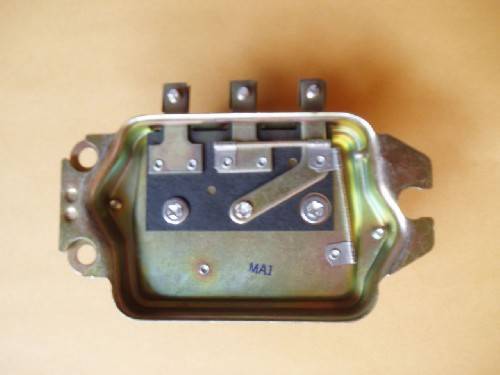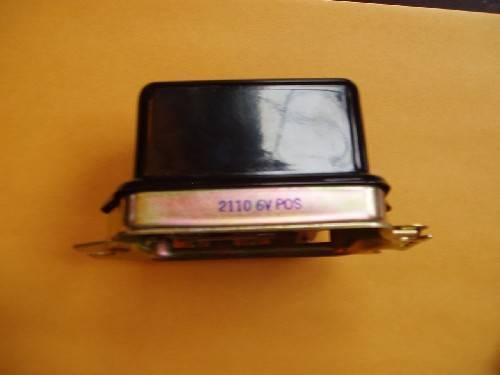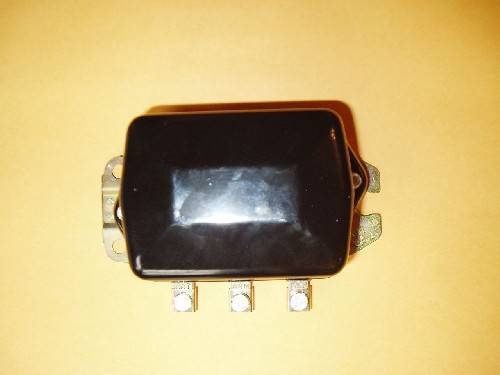|
Re: Engine cuts out on highway & up hill...
|
||||
|---|---|---|---|---|
|
Just can't stay away
|
This is a long shot, but I had the same problem recently. Turned out the trouble was due to a failing voltage regulator. The unit just wasn't putting out enough juice to charge the battery properly.
My auto electric expert tells me that these 6-volt voltage regulators can--and do--fail more frequently than you expect. All the best and good luck, Mark
Posted on: 2012/4/10 12:15
|
|||
|
||||
|
Re: LED versus halogen bulbs
|
||||
|---|---|---|---|---|
|
Just can't stay away
|
David--
How about the turn signals at night, when the running lights are all on? Are the turn signals noticeably brighter, too? Thanks, Mark
Posted on: 2012/2/22 23:18
|
|||
|
||||
|
Re: LED versus halogen bulbs
|
||||
|---|---|---|---|---|
|
Just can't stay away
|
David--
Based on your recommendation I just bought two halogen tail light bulbs for my 1950 Standard Eight. I spoke with Eric Hirsch and ordered the 1154 dual filament, bayonet with offset pins, 6-volt models in halogen. Price was $17 each. With shipping, it came to a flat $40. I shopped around, a bit, online and couldn't find a deal better than that. Last time I bought a standard, tungsten tail light bulb at the local auto parts store, they were about $3 each. But I've never been happy with my tail lights' dimness, particularly when I use the turn signal at night. It scares the bejesus out of me to be hurtling down the freeway during the evening rush hour not knowing whether the drivers immediately behind me are aware I'm planning to change lanes. If I'm planning to slide left I roll down the window and use a hand signal, just to be safer. But if I want to ease right I use the tail light signal AND do a lot of head-swiveling before I change lanes. Even so there have been times when I obviously took the driver behind me by surprise. Hopefully the new halogens will pay for themselves in stress reduction alone! On another note, did you ever get those pictures taken? All the best, Mark
Posted on: 2012/2/21 13:24
|
|||
|
||||
|
Reply to John Meehan
|
||||
|---|---|---|---|---|
|
Just can't stay away
|
Hi, John,
I sent you a private message. Check your inbox! Mark in SeattleQuote:
Posted on: 2012/2/21 11:34
|
|||
|
||||
|
Re: oil bath air cleaner
|
||||
|---|---|---|---|---|
|
Just can't stay away
|
Regarding whether paper air filters do a better job protecting our engines than oil bath air filters:
I have no idea if this anecdotal evidence is true, but several old-timers here in the Seattle area commented to me that oil bath filters are superior. They said that back in 1980, after the Mount. St. Helens volcano blew, many vehicles equipped with paper filters experienced engine failures. This happened, they reported, because fair amounts of volcanic ash got through the paper filters and got sucked into the engines. The ash tore up piston rings, contaminated the engine oil, etc. They went on to claim that this did not happen to vehicles equipped with oil bath air filters. They say the oil bath filters protected the engines and that ash-related engine failures were rare in vehicles that carried those filters. Again, I have no firsthand experience regarding this matter; I'm merely passing on what I heard! All the best, Mark
Posted on: 2012/2/20 22:47
|
|||
|
||||
|
My Packard's solo adventure
|
||||
|---|---|---|---|---|
|
Just can't stay away
|
I keep my 1950 Packard Eight in a garage out in the alley behind my building. The garage consists of four bays that stair step down the alley's slight incline. My Packard's home is in the highest unit, which is more shed than garage. There is no garage door, just a roof supported by three sides of the bay. Two of the other units--the ones farthest down the incline--do have garage doors.
Parking the car in the garage involves driving up the alley and then swinging hard to the left as I nose the Packard into its space. Backing out is basically the reverse procedure. That means the car's front wheels are always turned hard left when parked. The floor of my garage is not exactly level. Rather, it is very slightly tilted toward the alley. Sometimes I remember to set the hand brake when I park the car, but at other times I just leave the car in first gear and walk away. As long as the car doesn't roll backwards I figure it's doing fine. During a recent spate of electrical problems I asked my mechanic, Jerry, to come to my place to install a new voltage regulator. With the Packard in its garage, Jerry pulled out the old unit and got the new one connected. Then he hopped in the car, put the transmission in neutral, and fired up the engine. After a bit he asked me to take over revving the engine while he ran some tests. A short time after that he declared the job done and directed me to shut down the engine. I complied and exited the car while we congratulated ourselves on our success. Jerry went on his way and I walked back home. About an hour later, I needed to run an errand. I walked out into the alley and was astonished at what I saw. The Packard was out of the garage and facing the opposite direction from when it was parked. It was also completely blocking the alley; it was sideways across the narrow lane. As I walked toward the car a utility worker ran over to me. "I watched it happen," he said. "The car just rolled backwards out of the garage. It swung in a 180-degree arc, and the rear bumper smacked into that garage door right there." He pointed to one of the downhill doors. It had a significant hole and was off its track. "Then," he continued, "the car rolled forward and stopped right here, in the middle of the alley." I checked the Packard's rear bumper. Aside from a smudge of paint that matched the color of the garage door, there was no damage. I thanked the utility guy and put my errand-running on hold. I returned the Packard to its stall and this time I both left it in gear AND set the hand brake. My immediate concern was to take responsibility for the damage to my neighbor's garage door. I had no idea who the garage owner was, so I headed back home to work the phone and make inquiries. After a fruitless couple of hours, I gave up and decided to post a note on the door with my apologies and contact info. As I walked down the alley the same utility guy came running. "I saw it happen," he said. "The lady who uses this garage drove up. She hit the garage door opener and the door opened. Then she drove into the garage. Before she could get out the whole garage door fell on top of her car!" I looked at the garage and there it was--the door hard on top of a Volvo. "Was she OK?" I asked apprehensively. "Did she get hurt?" "No," the guy said. "It looked like she was OK. She did seem a little mad, though, when she found out why the door fell." I scribbled even more apologies on the note and left it in the Volvo. Then I went home and waited for the inevitable call. In the meantime I contacted my insurance company and made a full report. I had to explain three times to the State Farm lady what happened. She seemed to have a hard time understanding how a car that was rolling backwards could hit the same building it had just exited. Awhile later, the Volvo lady called. She was not happy but at least she didn't chew my ear off. Everything turned out reasonably well. The Volvo lady got her garage door repaired and the damages to her car were minor. The insurance company picked up the tab, less my deductible. I figure that is my penalty for foolishly walking away from my car with the transmission in neutral and hand brake not set. The other day the Volvo lady and I ran into each other at the garage. She seemed genuinely friendly and waved off my profuse apologies. Then she gave me a smile and a pat on the arm. "I just want to let you know," she said, "that I really like your car."
Posted on: 2012/2/17 16:52
|
|||
|
||||
|
Equipment follow-up
|
||||
|---|---|---|---|---|
|
Just can't stay away
|
Hi again,
It's taken me awhile to sort out the question about what equipment I went through during this process. I don't have a complete list, but I'll give you what I can. When all this started the car had a Delco 1102715 generator and a Delco voltage regulator, part unknown. I ordered a rebuilt Delco 1102715 from Tucson Packard. To the best of my recollection I also ordered from Tucson--and received--a NOS Delco voltage regulator, part number unknown. I clearly recall a Delco stamp on the regulator's shell. I also clearly remember the folks at Tucson stressed they needed the exact Delco generator number so they could match the regulator with the generator. After the Tucson regulator failed I purchased a voltage regulator from a local source, Blanchard Electric. They sold me an aftermarket unit that they ordered from a supplier in Ohio: J&N Electric: http://www.jnelectric.com/ This unit has an internal J&N part number of 231-12018 I have attached three photos of the J&N unit to this post. I can't get any more info on the unit than what I have shared here. The final regulator (the one that's working and in the car right now) that was installed by Acme Electric was made by Regitar, part number 8040-6161. I have attached a screen capture from the Regitar website of that particular unit. I don't know which unit Acme installed in the Packard before they opted for the Regitar 8040-6161. All I know is it was a 6-volt, positive ground regulator. The unit in the car right now is a "universal" model. I hope this helps! Mark
Posted on: 2012/2/17 15:39
|
|||
|
||||
|
Getting a jump/Gener-Nator or Powergen/Intermittent power drop follow-up
|
||||
|---|---|---|---|---|
|
Just can't stay away
|
Hello, all,
For the past several months I have been posting queries (under several different headings) about my manyfold electrical problems. Between October 2011 and February 2012 my 1950 Packard has had the following installed in it: three batteries, three generators and five voltage regulators. As of today (Valentines Day, 2012) it appears the electrical mystery has been solved. So I thought I'd give those of you who are interested the skinny on what happened, how the craziness evolved, and how it was resolved. I'm consolidating all my previous posts/queries into this summary document in order to bring the loose threads together. It all started last autumn, when I noticed my ammeter--the "Battery Charge Indicator gauge," was occasionally swinging wildly from charge to discharge for no apparent reason. I use my Packard as a daily driver, so as the winter here in Seattle came on I began to experience electrical problems as my use of lights & blower (not to mention the radio) increased. The battery suddenly failed in October and I posted my beginning query here: "Getting a Jump," about how I had to call AAA to re-start the car. The AAA guy only had a 12-volt power source, and I wondered if the 12 volts had fried anything. I bought a new battery but less than three weeks later it failed completely. My solution was to buy another new one. Fortunately, that battery is still working well. As winter deepened I noticed my car was seriously losing power while I was sitting at an intersection waiting for the stoplight to turn. The headlights grew dimmer and dimmer, while the blower motor made howling sounds. When the light turned green I'd let up the clutch and depress the accelerator. When I did this the ammeter would swing wildly to the left, the discharge side. Sometimes the car would lose power entirely and I'd end up stalled in the middle of the intersection. I assumed the old generator was giving out and was considering replacing it with a "Gener-Nator" or a "Powergen" unit. Those are alternators in a generator skin. Several kind (and smart) people here urged me to lubricate the blower motor and to consider staying with the original equipment, i.e. a generator. I had the blower motor lubricated and it now hums smoothly. I also ordered a rebuilt generator and a NOS voltage regulator from Tuscon Packard. Jerry my mechanic, installed those units but was very dissatisfied with the equipment. He reported that when he started the car the generator began to smoke. So he shut down the engine and checked the voltage regulator. According to Jerry, the contacts in the regulator were "frozen" in one position. He assumed this was due to age. So Jerry removed the new, NOS regulator and re-installed the old one. The car ran well for a day or so and then the wildly-swinging ammeter problem returned. A new twist developed when the generator apparently had enough juice to charge the battery when no electrical accessories were running. But when I drove at night with the headlights on the ammeter would show significant power drain. At first this circumstance was intermittent. But over a few days it became obvious the "new" generator was putting out very little juice. Jerry and I decided the problem was with the old voltage regulator. So I ordered an aftermarket regulator. That unit cost about $100, with delivery fees and taxes. Jerry installed it and for a day or so everything seemed to work well. Then the old problems returned: the battery wasn't charging and the car seemed woefully underpowered. After running a few tests a week ago, Jerry admitted defeat. He suggested I turn to an expert: 76-year-old Les, owner of Acme Auto Electric, here in Seattle. I made an appointment with Acme and delivered the car the morning of Thursday, Feb. 9. When I dropped the car off the original Delco generator that Jerry had removed was in the Packard's trunk. Its replacement--the rebuilt unit from Tucson--was still in place, in the car. At noon Les called me and reported the "new" generator (the one that was on the car, that I'd bought from Tucson Packard) was toast. He said it was all burned up and basically worthless. He also reported the voltage regulator was in need of replacement. Les's crew had tested the original generator and said it could be rebuilt, so I authorized the rebuilding and the purchase of yet another voltage regulator. At about 3 p.m. I called Les and asked about the status of my Packard. He reported all was well and the car would be ready in about 20 minutes. I took a taxi to the shop and was greeted with embarrassed smiles. Turned out the car was not ready to go after all. With the newly-rebuilt generator and the new voltage regulator installed the old problem was still there: the ammeter was swinging wildly on an intermittent basis. For the next 90 minutes Les and crew worked to troubleshoot the situation. Eventually they ruled out a faulty ammeter. The 61-year-old gauge was working admirably. They were literally stumped for an answer when Les suggested they swap out the brand new, tested-and-found-to-be-working voltage regulator for a different unit. It turns out that there are three different kinds of voltage regulators for cars of my Packard's vintage: 6-volt positive ground (the kind my Packard takes), 6-volt negative ground, and a newer, "universal" type, that can handle either positive or negative ground. Les and crew swapped out the brand new, 6-volt positive ground voltage regulator--the fourth such unit that had been on my car since October--for a "universal" model. The results were immediate. The system calmed down and everything began to work as intended. Over the weekend I put more than 250 miles on the Packard. I can honestly say it has never run better in the eight years I've owned it. Acceleration is smooth and it seems as if I have about a 15% increase in available horsepower. Over the past eight years I've replaced just about every part of the car's electrical system. It's been completely re-wired and I've installed numerous new relays & switches, not to mention motors and bulbs. As of today the only electrical part that was on the car when I bought it in 2004 is the starter motor. I replaced the starter solenoid last year. But with 20/20 hindsight I'd have to say that if I were to do things again I'd do two things differently: 1. I'd find a company like Acme--or a guy like Les--to do the electrical work. At the end of the day on Thursday Les commented that electrical system was a car's most complicated system--and I agree. 2. I'd ask that company (or person) to replace the existing generator and voltage regulator as part of the electrical system rebuild. This is no slam on Jerry, who is a very competent mechanic, but it appears to me electrical problems are best left to the experts. All I can say is that I paid for two rebuilt generators and three voltage regulators before the problem was fixed--not to mention labor costs, which were significant. In my humble opinion going to Acme first would have saved me a fair amount of time and money! I hope you find this saga useful..... Mark
Posted on: 2012/2/15 1:12
|
|||
|
||||
|
Response to BH
|
||||
|---|---|---|---|---|
|
Just can't stay away
|
Quote:
He jumped from the 'hot' (positive) wire on the generator directly to the positive terminal on the battery....The problem instantly corrected itself. Are you trying to say that your mechanic jumpered the generator's ground (G) terminal directly to the battery's ground (+) terminal and solved the problem. That would indicate a deficient ground for the generator.[/quote] Sorry, gentlemen, I misspoke (miswrote?). What Jerry did was to jump from the hot wire on the generator to the negative (-) terminal on the battery. This 6-volt, positive ground business tends to get me confused. Anyway...on my car the terminal marked (-) is the terminal closest to the headlights. The terminal marked (+) is toward the firewall. Jerry's jumper went to the (-) terminal. He indicated the wire on the generator that he jumped from was the wire that carried away the juice the generator produces. I hope this makes sense to those of you who understand these things.
Posted on: 2012/2/5 13:34
|
|||
|
||||

 (31.47 KB)
(31.47 KB)










